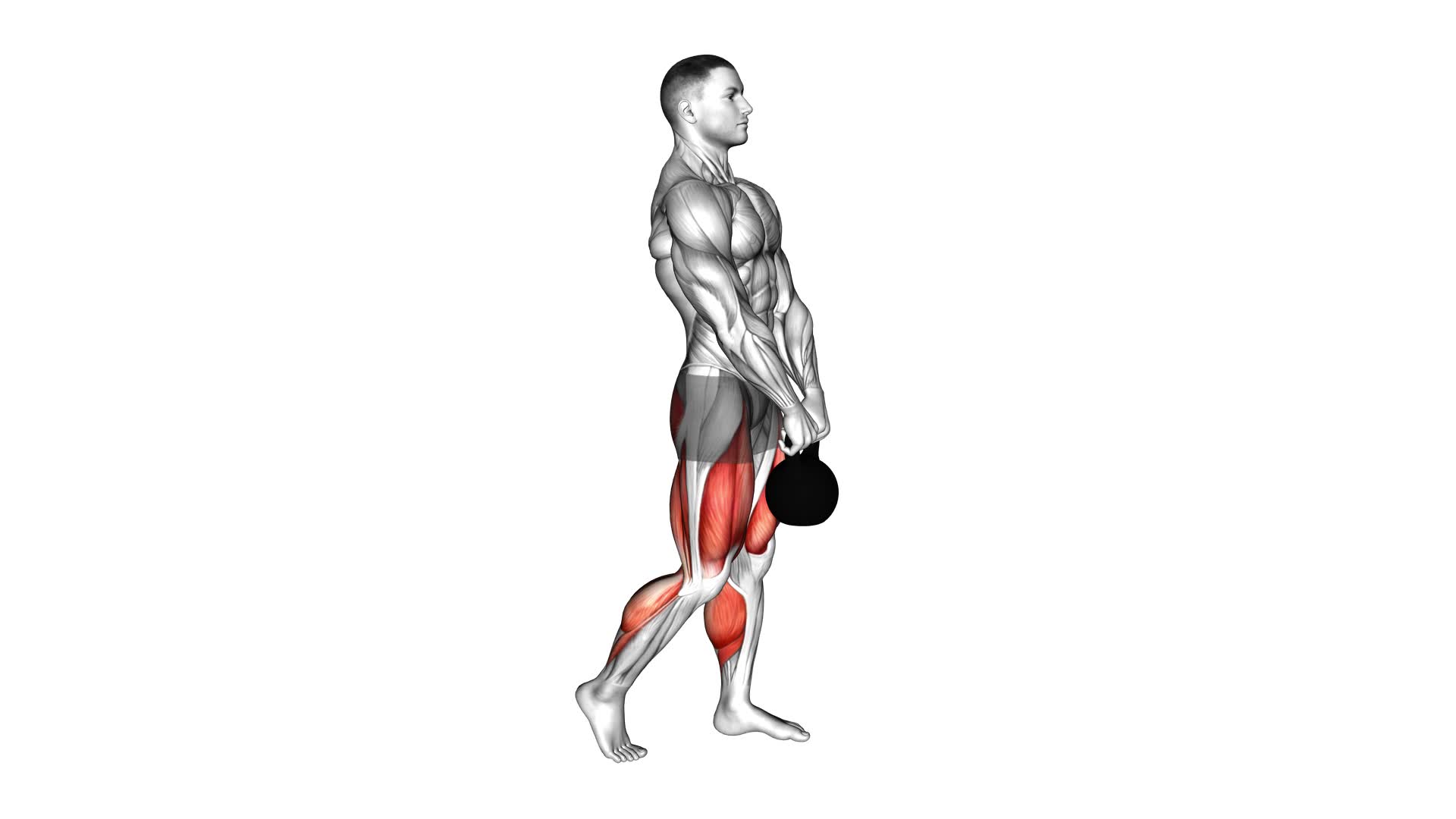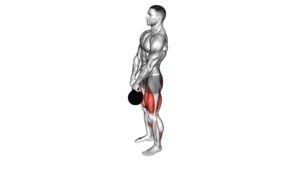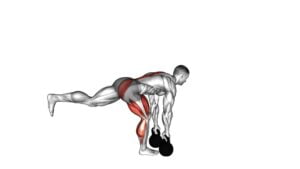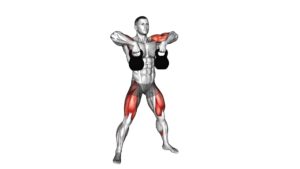Kettlebell Kickstand One Leg Deadlift – Video Exercise Guide & Tips

Looking to improve your balance and strengthen your lower body? The Kettlebell Kickstand One Leg Deadlift is the perfect exercise for you.
Watch This Exercise Video
In this video exercise guide, we'll show you the proper form and technique, along with common mistakes to avoid. We'll also provide variations to challenge yourself and tips for progression.
Whether you're a beginner or experienced, this exercise will help you achieve your fitness goals.
Let's get started!
Key Takeaways
- The Kettlebell Kickstand Deadlift improves posture and overall strength.
- It targets back, core, and lower body muscles, particularly the glutes, hamstrings, and quadriceps.
- Proper form and technique, including maintaining a straight back and avoiding rounding, are essential for this exercise.
- Balance and stability can be improved by engaging the core, incorporating balance exercises, and strengthening the core with exercises like planks and bird dogs.
Benefits of the Kettlebell Kickstand Deadlift
What are the benefits of performing the Kettlebell Kickstand Deadlift?
The Kettlebell Kickstand Deadlift is a highly effective exercise that offers numerous benefits for improving posture and increasing strength.
By incorporating this exercise into your workout routine, you can experience significant improvements in your overall posture. This is because the Kettlebell Kickstand Deadlift targets the muscles in your back, core, and lower body, which are essential for maintaining proper alignment and posture.
As you perform the exercise, you engage your glutes, hamstrings, and quadriceps, which helps strengthen these muscles and improve their function. Additionally, the Kettlebell Kickstand Deadlift also activates your core muscles, helping to stabilize your spine and improve your overall balance.
By consistently performing this exercise, you can develop a stronger and more stable core, leading to improved posture and reduced risk of injury.
Furthermore, the Kettlebell Kickstand Deadlift is an excellent exercise for increasing overall strength. It targets major muscle groups, such as the glutes, hamstrings, and quads, helping to build strength and power in these areas.
This exercise also involves the use of kettlebells, which adds an extra challenge and resistance to the movement, promoting muscle growth and strength development.
Incorporating the Kettlebell Kickstand Deadlift into your fitness routine can lead to significant improvements in both your posture and overall strength.
Proper Form and Technique for the Exercise
To perform the kettlebell kickstand one leg deadlift with proper form and technique, it's important to focus on balance and stability.
Keep your core engaged and maintain a straight back throughout the exercise.
Avoid common mistakes such as rounding your back or relying too much on your supporting leg for stability.
Balance and Stability Tips
Maintain proper balance and stability throughout the kettlebell kickstand one leg deadlift by engaging your core and grounding through your supporting leg. This exercise challenges your balance and stability, making it important to focus on maintaining the correct form and technique.
To improve your balance and stability, incorporate balance and stability exercises into your training routine. These exercises can include standing on one leg, using a balance board, or performing exercises on unstable surfaces such as a Bosu ball.
Additionally, working on improving your core strength is crucial for maintaining stability during the kettlebell kickstand one leg deadlift. Include exercises such as planks, Russian twists, and bird dogs in your workouts to strengthen your core and enhance your overall stability and balance.
Common Mistakes to Avoid
Ensure proper form and technique during the kettlebell kickstand one leg deadlift by keeping your back straight and engaging your glutes. Common mistakes can lead to injury, so it's important to be aware of them and take steps to prevent them.
One common mistake is rounding the back, which puts unnecessary strain on the spine. To avoid this, focus on maintaining a straight and neutral spine throughout the movement.
Another mistake isn't engaging the glutes enough, which can lead to compensation from other muscles and potential imbalances. Make sure to squeeze your glutes at the top of the movement to activate them properly.
By being mindful of these common mistakes, you can reduce the risk of injury and maximize the effectiveness of the kettlebell kickstand one leg deadlift.
Transitioning into the next section, let's explore some specific common mistakes to avoid.
Common Mistakes to Avoid
To perform the kettlebell kickstand one leg deadlift with proper form, it's important to keep a few tips in mind.
First, focus on maintaining balance and stability throughout the exercise by engaging your core and keeping your body aligned.
Additionally, be mindful of your back and avoid rounding or arching it, as this can lead to injuries.
Proper Form Tips
Avoid leaning too far forward during the Kettlebell Kickstand One Leg Deadlift. This is one of the common mistakes to avoid when performing this exercise. Proper form is crucial to ensure maximum effectiveness and prevent injury.
To maintain proper form, keep your back straight and hinge at the hips to lower the kettlebell. Avoid rounding your back or letting your shoulders droop. Engage your core and glutes to maintain stability throughout the movement.
It's also important to maintain a slight bend in your standing leg to help with balance and stability.
Balance and Stability
Maintain your balance and stability by focusing on proper form and engaging your core and glutes during the Kettlebell Kickstand One Leg Deadlift. This exercise not only targets your lower body muscles but also helps in improving posture and core strength.
To enhance your balance, keep your standing foot firmly planted on the ground and distribute your body weight evenly. Avoid leaning too far forward or backward, as it can throw off your balance.
Engage your core muscles by pulling your belly button towards your spine and squeezing your glutes throughout the movement. This will provide stability and prevent any unnecessary swaying or wobbling.
Avoiding Back Injuries
To prevent back injuries and ensure proper form, focus on maintaining a neutral spine position throughout the Kettlebell Kickstand One Leg Deadlift. This is crucial for preventing lower back pain and strengthening core muscles.
When performing the exercise, make sure your back is straight and not rounded or arched. Engage your core muscles by pulling your belly button towards your spine, creating stability and support for your lower back.
Avoid lifting the kettlebell too quickly or using momentum, as this can strain your back. Instead, move slowly and control the movement, keeping your back straight and your core engaged throughout.
Variations to Challenge Yourself
Looking to challenge yourself? Try out some variations of the kettlebell kickstand one leg deadlift!
There are several different equipment options and advanced variations that can help take your workout to the next level.
To add an extra challenge, you can use a heavier kettlebell. This will increase the resistance and make your muscles work harder.
Another option is to try the exercise on an unstable surface, such as a BOSU ball or a balance board. This will engage your core and stabilizer muscles even more.
If you're looking for an advanced variation, you can try the kettlebell kickstand one leg deadlift with a rotation. Instead of just lifting the kettlebell straight up, you can rotate your torso to the side as you lift the weight. This will engage your obliques and add an extra challenge to the exercise.
By incorporating these variations into your workout routine, you can continue to challenge yourself and make progress. As you become more comfortable with these advanced variations, you can start to increase the weight or the difficulty level to keep pushing yourself.
Now that you know about the variations to challenge yourself, let's move on to the next section where we'll discuss tips for progression and increasing difficulty.
Tips for Progression and Increasing Difficulty
To increase the difficulty of the kettlebell kickstand one leg deadlift, you can gradually add more weight to the kettlebell. This will challenge your balance and strength, forcing your muscles to work harder. Start by using a kettlebell that you can comfortably lift for 8-12 repetitions.
Once you feel confident and ready to progress, add a small amount of weight to the kettlebell, such as 2-5 pounds. Focus on maintaining proper form and balance as you perform the exercise with the increased weight.
As you continue to improve and get stronger, you can gradually increase the weight of the kettlebell. This progression will help you build strength and stability in your legs, glutes, and core muscles.
Additionally, you can incorporate advanced techniques to further increase the difficulty of the kettlebell kickstand one leg deadlift. These include performing the exercise on an unstable surface like a balance board or BOSU ball, or adding a pause at the bottom of the movement to challenge your balance and control.
Remember to always listen to your body and progress at a pace that feels challenging but manageable for you.
Safety Precautions and Modifications for Beginners
If you're a beginner, it's important to take certain safety precautions and make modifications when performing the kettlebell kickstand one leg deadlift. This exercise can be challenging, but with the right modifications, you can still benefit from it while reducing the risk of injury.
Here are some beginner modifications and injury prevention precautions to keep in mind:
- Start with a lighter kettlebell: As a beginner, it's important to choose a kettlebell that you can handle with proper form. Starting with a lighter weight will help you focus on your technique and reduce the risk of strain or injury.
- Use a support: If you find it difficult to balance while performing the kickstand one leg deadlift, you can use a support like a chair or wall for stability. This will help you maintain proper form and prevent any accidents or falls.
- Engage your core: To protect your lower back and maintain stability, engage your core muscles throughout the exercise. This will provide a solid foundation and help you maintain balance.
- Focus on technique: Instead of trying to lift heavy weights right away, focus on mastering the proper technique. This won't only help prevent injury but also ensure that you're targeting the right muscles.
Frequently Asked Questions
How Many Repetitions Should I Do When Performing the Kettlebell Kickstand One Leg Deadlift?
When performing the kettlebell kickstand one leg deadlift, it's important to consider how many repetitions you should do. The number of repetitions can vary depending on your fitness level and goals.
It's recommended to start with 8-12 repetitions per leg and gradually increase as you get stronger.
This exercise offers numerous benefits, such as improving balance, strengthening the lower body muscles, and enhancing core stability. Incorporating it into your workout routine can lead to better overall strength and stability.
Can I Use Dumbbells Instead of Kettlebells for This Exercise?
Yes, you can definitely use dumbbells instead of kettlebells for the exercise. While kettlebells offer unique benefits like increased grip strength and a different range of motion, dumbbells can be a suitable alternative. They still provide resistance and target the same muscle groups.
However, it's important to note that kettlebells are specifically designed for exercises like the kickstand one leg deadlift, which allows for better stability and control.
Ultimately, it's up to your personal preference and what equipment you have available.
Should I Perform This Exercise on Both Legs or Just One Leg at a Time?
To perform this exercise, you have the option of doing it on both legs or just one leg at a time. Both variations have their benefits.
Performing the exercise on both legs helps with stability and overall strength.
On the other hand, doing it on one leg at a time enhances balance, coordination, and targets individual leg muscles.
Incorporating single leg exercises into your routine can provide a well-rounded workout and improve functional strength.
Is It Normal to Feel Soreness in My Hamstrings After Doing the Kettlebell Kickstand One Leg Deadlift?
Feeling soreness in your hamstrings after doing the kettlebell kickstand one leg deadlift is normal. This exercise targets your hamstrings, so it's expected to feel some discomfort afterwards.
To minimize soreness, make sure you maintain proper form and technique throughout the exercise. Engage your core, keep your back straight, and focus on using your hamstrings to lift the kettlebell.
Additionally, don't forget to stretch and foam roll your hamstrings after your workout to help reduce soreness.
Can This Exercise Help Improve My Balance and Stability?
Improving your balance and stability is important for overall fitness and preventing injuries.
The Kettlebell Kickstand One Leg Deadlift is an exercise that can help you achieve this. By challenging your body to maintain balance on one leg while performing the deadlift movement, you're strengthening the muscles in your core, hips, and legs that are responsible for stability.
This exercise can be a great addition to your workout routine if you're looking to improve your balance and stability.
Conclusion
In conclusion, the kettlebell kickstand one leg deadlift is a highly effective exercise for improving strength, balance, and stability. By following proper form and technique, avoiding common mistakes, and challenging yourself with variations, you can maximize your results and progress in difficulty.
Beginners should take safety precautions and make modifications as needed. Incorporating this exercise into your workout routine can lead to significant improvements in your overall fitness level.

Author
Years ago, the spark of my life’s passion ignited in my mind the moment I stepped into the local gym for the first time. The inaugural bead of perspiration, the initial endeavor, the very first surge of endorphins, and a sense of pride that washed over me post-workout marked the beginning of my deep-seated interest in strength sports, fitness, and sports nutrition. This very curiosity blossomed rapidly into a profound fascination, propelling me to earn a Master’s degree in Physical Education from the Academy of Physical Education in Krakow, followed by a Sports Manager diploma from the Jagiellonian University. My journey of growth led me to gain more specialized qualifications, such as being a certified personal trainer with a focus on sports dietetics, a lifeguard, and an instructor for wellness and corrective gymnastics. Theoretical knowledge paired seamlessly with practical experience, reinforcing my belief that the transformation of individuals under my guidance was also a reflection of my personal growth. This belief holds true even today. Each day, I strive to push the boundaries and explore new realms. These realms gently elevate me to greater heights. The unique combination of passion for my field and the continuous quest for growth fuels my drive to break new ground.







